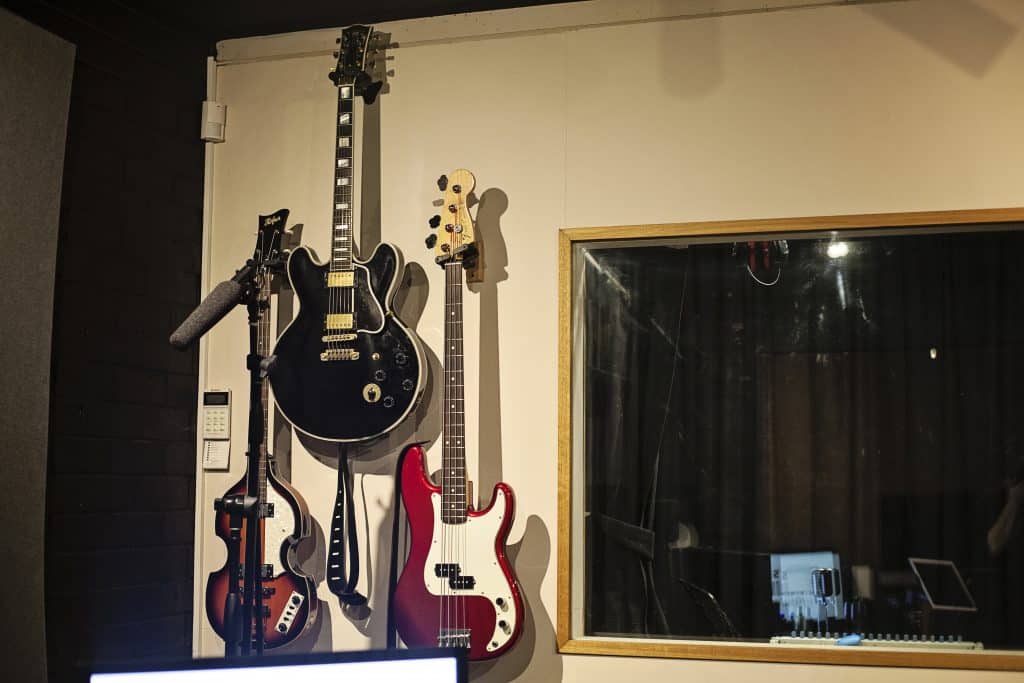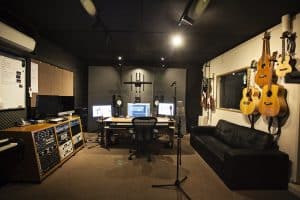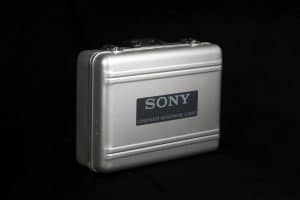Recording Studio Glossary – A
Recording studio glossary can be very foreign to people who have never been in the audio environment before. We have decided to create a series of articles which are essentially the creation of a recording studio glossary. This will be made accessible to our clients. It is designed to help them understand some of the language that is be used in the recording studio. Recording studio engineers should always make communication to the client as accessible as possible. Unfortunately there are times when this is not possible because terms to describe processes and concepts in the recording studio do not exist in a simpler format. If any readers of this blog feel that we have missed any critical terms please let us know and we will add them immediately.

Some of our guitars at Crash Symphony Productions.
Recording Studio Glossary – A
A-B Roll This is a cutting system that is used to cut film negatives. The edited parts of the negative are placed in two rolls in an alternating sequence. This provides the editor with the opportunity to add effects to the original film.
A-Weighting This is where a technical adjustment has been made to sound level meter. It must read the input signal similar to that of the human ear.
Abfussor These are acoustic panels of varying size that can be used in the treatment of a studio or control room. These panels can be used for both reflective and absorptive purposes depending on the design.
Absolute Pitch This is considered to be rare gift where a person is born with the ability to recognize the exact musical pitch of a note perfectly without fail. It is different from relative pitch where seasoned musicians develop the ability to accurately guess a note because they hear those notes on a regular basis. Perfect pitch can be both a blessing and a curse. It is clearly useful to working musicians, but it is known to be stressful to those people when they are constantly bombarded by out of tune notes that they encounter in day-to-day life. For example, the brakes of a bus or a kettle boiling will be distinctly recognised as being out of tune to people with perfect pitch.
Further Term Starting with A in the recording studio glossary
Absorption is the acoustic term for sound wave absorption. This is the degree at which a surface will absorb the acoustic energy of a sound wave and not reflect it.
Absorption Coefficient This is the fraction of sound energy that is absorbed by a particular material. It is usually unique to each type of material (For example, brick, carpet or wood). Each absorption coefficient is a number between 0 and 1. An absorption coefficient of 0.5 would indicate that the particular material absorbs 50% of the sound energy that comes in contact with the surface. 0.15 would mean 15% is absorbed, etc.
AC stands for Alternating Current. AC flows back and forth between opposite poles in a circuit. All audio signals in a studio are in the AC form (as opposed to DC which is the abbreviation of Direct Current).
Acoustic Related Terms in the Recording Studio Glossary
Acoustic (or Acoustical) is the word that we use for sound energy that can be heard by our ears.
Acoustics is the behaviour of sound energy and the study of sound mechanics. The acoustic properties of a room depend on the room dimensions and the material composition of the room. Introducing sound absorption material or sonically reflective surfaces can alter room acoustics.
Acoustic Amplifier is the component of an instrument that makes the vibrating source move more air more efficiently. This amplifies the instrument. Examples of acoustic amplifiers include:
a) the body or resonator of an acoustic guitar,
b) the sounding board of a grand piano,
c) the bell of a horn and
d) the shell of a drum.
Acoustic Baffle This is a sonic partition, very similar to those found in offices that is designed to acoustic separate two spaces. They can be used as sound dividers.
Acoustic Centre This is the point where a sound has originated. It is the sonic epi-centre.
Acoustic Lens This is a component that can be attached to a high frequency speaker that will act to increase the sonic emanation angle of the speaker or horn.
More Words to Help the New Comer
Acoustic Suspension System This is a system that is set up within a loud speaker. The volume inside the speaker cabinet is sealed and the trapped air acts to resist the acoustic energy. That derives from the speaker cone.
Acoustic Echo Chamber is a space that is designed with very hard and non-parallel surfaces that promote the echo of sound inside the chamber. A microphone and speaker is placed in the chamber and signals can be sent from the studio console to the chamber through the speaker. The sound will reverberate in the room and will be captured by the microphone, which in turn, will send the signal back to the console. This captured reverberation can be used on studio recordings.
Action refers to the height that the strings of a stringed instrument sit off the instrument neck. When the strings of the instrument sit very close to the neck. This is referred to as having a “Low Action”. When they sit far away it is referred to as having a “High action”.
Active Crossover is a method of power supply that uses active devices such as transistors, IC’s or tubes to operate.
Active Microphones require power to operate. The power can be supplied either by battery or by phantom power. Generally active microphones are more sensitive than inactive microphones.
More Words to Help the New Comer
A/D is the widely used abbreviation for Analog-to-Digital Conversion. This is process of taking an electrical signal and converting it to binary (1’s and 0’s). This is so a computer can read it. The reverse is called D/A. For example, the signal that is captured by a microphone is an electrical signal. It needs to be converted into the language that computers can read which is called binary. When the computer is to send a signal to speakers it needs to convert that binary to an electrical signal. This is what is sent to the speakers.
ADAT
A trademark of Alesis Corporation designating its modular digital multi-track recording system released in early 1993.
ADSR These are the letters that abbreviate the phases of a wave (more specifically a transient). Attack, Decay, Sustain and Release. These are the phases of volume change in the cycle of a transient sound wave.
AES Audio Engineering Society.
More Words to Help the New Comer
AES/EBU This is a standard method for sending and receiving digital audio conventionalised by the Audio Engineering Society and the European Broadcast Union.
AFL After Fader Listen. This is a function where the sound is monitored after it has passed through the fader stage of the channel, and therefore, any changes to the fader during listening will be heard.
AFM Advanced Frequency Modulation
Algorithm This is a finite set of unambiguous rules and procedures that if employed in a prescribed sequence will achieve a desired end point. This is commonly used in mathematics and is the basis for all computing.
Aliasing This is the formation of an incorrect frequency that is referred to as the “Alias” Frequency. It occurs when a signal is sampled at a higher frequency than the Nyquist frequency. The system will misread this frequency and play it back at an incorrectly. This is a kind of distortion that is undesirable and there are many elegant methods that have been developed to eliminate the alias frequency.
AIFF This is a file format known as Audio Interchange File Format and is specific to Apple Macintosh operating systems.
More Words to Help the New Comer
Alignment This is the readjustment of an electronic device in the audio industry whereby it is recalibrated back to the manufacturers written specifications. Often with repetitive use devices like multi-track tape machines can fall out of the specified alignment and in order to achieve the optimal operating conditions the machine requires frequent recalibration.
Alignment Tape This is a tape that is used on a multitrack tape machine that is designed to help recalibrate the machine. It will have different test tones and reference levels that help this process.
Ambience This is the component of a sound that derives from the surrounding environment rather than being directly from a sound source. For example, in the process of recording drums the room will respond to the acoustic energy of the drums in a characteristic way. This sound will be different to the sound captured by the microphones that are placed close to the drums. Ambience is also used to refer to the atmosphere of an environment. This use of the word is more common in the film or post-production industry. It may be the sound of a field or the country or the sound of bustling city.
More Words to Help the New Comer
Ambient Field is an alternative meaning for the term Reverberant Field (the area away from the sound source where the reverberation is louder than the direct sound).
Ambient Miking is the process of placing a microphone in the reverberant field (where the reverberation is louder than the direct sound) in order to record the ambience or to allow the option to change the mix of direct to reverberant signal in the recording.
Amp 1) an abbreviated term for Amplifier. An amplifier is a device that increases the level of an electrical signal.
2) an abbreviation for Ampere (the unit of electric current).
3) an abbreviation of amplitude (the height of a waveform that translates to the volume of the sound).
Ampere The unit of current. It is abbreviated to Amp and is measured in coulombs per second.
Amplification This is an increasing of signal strength that in turn results in an increase of volume.
Amplifier An electronic device that increases the amplitude (level) of an AC signal (making it louder) that is being fed through it.
More Words to Help the New Comer
Amplitude The amplitude of a wave is the maximum height of a waveform at a given point in the cycle. This translates to the maximum volume of the wave or the maximum strength of vibration of the wave.
Amplitude Distortion This occurs when the waveform of a signal becomes distorted.
Analogue often analog Of, relating to, or being a device in which data are represented by continuously variable, measurable, physical quantities, such as length, width, voltage, or pressure. In audio engineering, particularly since the emergence of the digital age, analogue recording is where the signal is kept in the electrical AC form and is not converted over to digital. When the signal is converted into a digital format it is not longer considered to be an analogue recording.
Analog Recording A recording of the continuous changes of an audio waveform.
Analog-to-Digital Converter The device that does the conversion (encoding) of an analogue signal (that has continuous changes – usually of voltage) into numbers that approximate those changes. A computer reads the numbers.
More Words to Help the New Comer
Anechoic The term used to describe a space or surface that has no echo or reverberation. Minimising sound reflection and preventing standing waves achieve an anechoic space.
Anechoic Chamber An anechoic chamber is a room that is sonically inactive (also referred to as sonically dead). There are no reflections and standing waves cannot form. These chambers are often used to test audio devices and other audio related equipment.
ANSI American National Standards Institute
APG Absorption Phase Grating
API Automated Process Incorporated. This is an US company that develops audio hardware, such as preamps, which are revered by audio professionals all over the world. API preamps are well noted for their effective recording of drums and electric guitars.
More Words to Help the New Comer
Arc In mathematics an arc is a potion of a circle’s circumference (or segment), but in audio engineering this is the term used to describe a visual spark that has bridged across an air gap and reached another point. It is not an ideal event because it suggests that there is an open flow of current and this can damage equipment that is not electrically protected.
Articulation This is the term used to describe the degree of intelligibility of someone’s speech. It is closely monitored when recording the speech or singing of a person because the intelligibility of their voice can vary depending of such variables as the microphone, compression, equalisation, preamp and the person’s vocal capability.
More Words to Help the New Comer
Artificial Reverberation This is reverberation that is created electrically, mechanically or acoustically which is then used on recordings to emulate specific spaces like tunnels, halls or large rooms.
ASA Acoustic Society of America
Assemble Editing This is a tape machine editing function whereby the erase head deletes all the information that has previously been recorded on to the tape.
Attenuator (Potentiometer or “pot”)
is the electronic element that is used to variably resist an AC current. It converts rotary (or linear motion) from the operator into a variation in resistance. In audio, this attenuation in the signal could be a variation in volume or a decrease in reverb level. Potentiometers are also colloquially referred to as pots.
More Words to Help the New Comer
Assistant Engineer is someone who is a responsible for the studio tasks that are usually more laborious like setting up microphones, keeping session paper work, operating tape machines or the DAW and for packing up all the equipment at the end of the session. They are there to assist the head engineer who is ultimately responsible for the session.
Atom This is the essential component of an element. The nucleus, which is made up of neutrons and protons, is orbited by electrons.
Attack The rate the sound begins and increases in volume. When you look at a transient waveform, for example, it is the section from the first point of activity to the maximum point of amplitude.
Attack Time This is a control on a compressor that controls how quickly the compressor will respond to an incoming signal. A fast attack time implies that the compressor will clamp down on the incoming signal very quickly. A long attack time indicates that the compressor will be slow to react. Most compressors will have a knob available for attack time, but others can have predetermined manufactured attack time that is not variable to the operator of the compressor.
More Words to Help the New Comer
Attenuation To reduce in energy; the reduction of electrical or acoustic signal strength as it passed through matter or an electrical component.
Attenuator A device with a variable resistance used to control the level of an electric signal. In acoustics this is any material that reduced the energy of a sonic component.
Audio Most often referring to electrical signals resulting from the sound pressure wave being converted into electrical energy.
Audio Frequency In audio we work within the frequency spectrum that lies between 20Hz and 20kHz. This is the scope of human hearing. Any frequency that lies within this frequency range is referred to as an audio frequency.
Audio Spectrum (human hearing and music) The audio spectrum is the frequency bandwidth between 20Hz and 20kHz. This is the scope of human hearing and in audio we usually limit our bandwidth of operation to this frequency bandwidth.
More Words to Help the New Comer
Auditory Pertaining to hearing, to the sense of hearing or anything associated with the organs of hearing.
Auditory Cortex This is the sensory area of the temporal cortex that is associated with the organ of hearing called the auditory area.
Auditory System The sensory system for hearing.
Auto Locator This is a remote control device that is part of a tape machine that provides the tape operator with all the functionality that they need for a recording session.
Automatic Gain Control (Automatic Volume Control)
A compressor with a very long release time used to keep the volume of the audio very constant.
More Words to Help the New Comer
Automation In consoles, a feature that lets the engineer program control changes (such as fader level) so on playback of the recording these changes happen automatically. Automation can is often done graphically in many modern DAW’s like Logic or Protools. A line is simply draw on along the track and then whichever component is being automated follows that line of automation. This is most often done with volume.
Aux Send (Auxiliary Send) This is a control used to adjust the level of a signal sent from the console or track input channel to the auxiliary equipment through the aux buss. For example, if there was a vocal on a channel an adjustable amount of that vocal could be sent to another location like a reverb unit. The vocal level on the channel that the signal originated would be unaffected. It can be thought of as a copy of what is happening on the original channel. Also, the amount of that copy being sent can be varied according to how much the engineer needs.
More Words to Help the New Comer
Auxiliary Equipment Any peripheral electronic devices. Not in direct communication (or under the control of) to the central processing unit. This may be a reverb unit or any other effects processor. Thus, that is not attached to the console or computer and signals are required to be sent to those devices. They are then returned to the central place of processing.
Auxiliary Input or Return A gateway back into the sound desk or channel. For a signal that has been sent to a piece of outboard equipment via an auxiliary send. This is the point of return for that signal.
Auxiliary Output or Send An additional output from a sound console or within the DAW. Monitoring via the main outputs is not required. Each input channel will have a path to the Aux buss. A signal can be fed to an effects processor via this method. (see Auxiliary Return).
More Words to Help the New Comer
Axis One, two or three reference lines in coordinate geometry. The point is located on a plane or in 3-dimensional space. Microphone placement references 3-dimensional space. The axis is an arbitrary line of reference to the orientation of that microphone in space.
Axial Mode These are standing waves that form within a room between parallel surfaces. There will be three main axes for modes to form in a standard cubic or rectangular room.
Azimuth In audio this is the angle between the head gap and the tape.
Azimuth Alignment This is the process of setting an optimal angle. This is for tape function between the head gap and the tape.
Contact Us to Learn more about our Recording studio Glossary
Crash Symphony Productions is a Sydney Recording Studio. We are located close to the beautiful Sydney Harbour Bridge. Would you like to learn more about our work.? We can help you with your project! Please call us on +61 408 300 402 or email info@crashsymphony.com.au.




